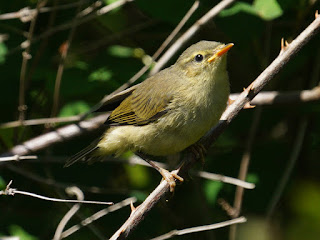It was another hot day. A Coot kept cool under a fountain in the Italian Garden.
Two Coot chicks at the bridge were out in the water, where they are kept fairly safe by projecting twigs.
The Coot nesting in the silly place on the edge of the Serpentine was repairing its nest, crushed down by a Greylag Goose using it as a resting place.
The single Great Crested Grebe chick on the Long Water is still all right. It its parents can keep it going there should be enough small fish for it to catch when it becomes independent in two months.
A pair of Egyptian Geese and five of their seven goslings rested in the shade of a willow beside the Serpentine.
The mother of the four cygnets at the island rushed around clearing other waterfowl away from her territory.
She seems to have kept away the aggressive male Mute Swan that probably killed one of her cygnets and all but one of another swan's. The sole survivor was being looked after very carefully on the far side of the boathouse.
The four cygnets on the Long Water were browsing near the Coot nest again, while its occupant stared at them resentfully.
Joan Chatterley was in Battersea Park, where she got a picture of a family of Mandarins. I think that only two pairs of Mandarins have ever managed to fledge young here, where there are too many gulls.
A Grey Heron looked down at the fish in the Italian Garden. The rail is slightly too high for them to reach down from, as we saw in the blog entry for 26 May, where a heron plunged right into the water.
But this one balancing precariously on a slightly lower chain at the island managed to pick up some bits of bread from the surface.
We haven't had a picture of a Jackdaw for a while. Here is one shelling a peanut I gave it.
The Chiffchaff family beside the Long Water were dashing about in the trees, making quite a noise. Here is one of the young ones.
Neil got a shot of a Coal Tit fledgling near the Albert Memorial ...
... and of its mother on a cedar.
Tom was at Thursley Common photographing one of his favourites, Colin the Cuckoo, now safely returned from Africa. When I was a boy there were Cuckoos in the park every spring. You were supposed to run a hundred paces when you hear the first one to avert ill luck.
A Buff-Tailed Bumblebee and two Honeybees browsed on an Allium flower in the Rose Garden.
The first damselflies have appeared in the Italian Garden, just two of them so far. I got one hasty shot of a Blue-Tailed Damselfly on a floating twig, but missed the other, a Common Blue which didn't stop.














Nice to see some Odonata turning up now. We had 4 damselfly species in our local country park on Monday & had a single Large Red in the garden.
ReplyDeleteWe should have more here soon. This pool is a good place for Red-Eyed and Small Red-Eyed, and on a larger scale Emperors and Migrant Hawkers.
DeleteFascinating
ReplyDelete"When I was a boy there were Cuckoos in the park every spring. You were supposed to run a hundred paces when you hear the first one to avert ill luck.
"
When did they decline - and why do think that was? Lack of food? Apparently there were many in the outer suburbs of London in the 1940s - but not for many years
I don't know. But I am sure that there is a small but perfectly formed PhD thesis waiting to appear on this topic.
DeleteAre they commoner in the countryside? Round here cuckoos are plentiful in the countryside but have vanished from city parks.
DeleteColin is a very fine fellow.
The Grebe chick is looking very well and in fine health. I am certain that it'll make it to independence.
Here Cuckoos are in decline nationally, and red-listed. They are almost totally absent from cities. I don't know why, and any theory is just a theory. The whole business of the rise and fall of urban bird species is a mystery.
Delete